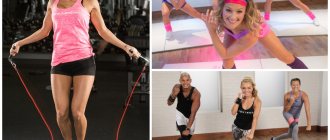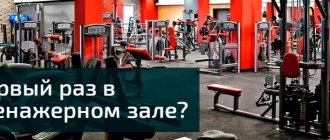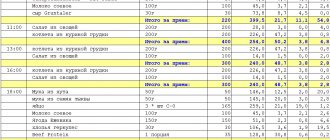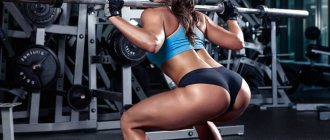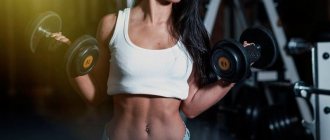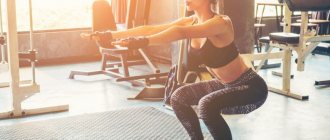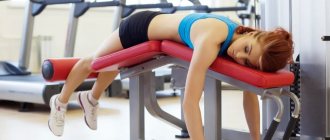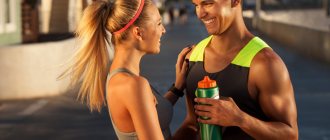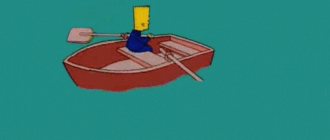What to eat during training? This question worries every amateur athlete who wants to get their body in shape. Without proper nutrition, the effect of exercise will be significantly lower - any person close to sports will confirm this.
In this material we will talk in detail about nutrition regimens for athletes. Which foods should you eat and which should you avoid? What's best to eat for lunch, breakfast and dinner? How to lose weight? You will learn the answers to all these questions from the article.
Developing a diet
Food is fuel for the body. While eating food, you receive a portion of proteins, fats, carbohydrates, vitamins and microelements necessary for normal life.
Proper nutrition is the key to success both for those who want to build muscle mass and for those whose goal is to lose weight. It is a well-designed diet that helps you achieve your goal in the shortest possible time.
To create your diet, you need to know your daily calorie intake. Here is a convenient calculator for calculation
First you need to decide on the purpose of your training. If you want to pump up, protein nutrition is suitable for you; if you want to lose weight, low-calorie diet options are suitable. You need to adjust yourself to the idea that now it will be impossible to eat everything at any time of the day. One of the basic principles of proper nutrition is the regularity of meals at the same time.
It is best to eat fractionally, in small portions. Meals should be balanced. It is recommended to eat complex carbohydrates and proteins for breakfast to fuel your energy for the rest of the day.
Let's talk in more detail about the products that are recommended for consumption during training.
Calorie intake for fitness enthusiasts
Everything has already been discussed, but the most important thing has been forgotten. Depending on your goals, you need to adjust your daily calorie intake . Using a bunch of formulas from the Internet, you calculate your norm, which you need in order for you to bloom and smell.
If you want to lose weight, then you need to create a calorie deficit. You can do this in two ways, either eat less or spend more. As for weight loss nutrition for girls during training, I would advise choosing the second option .
And if your goal is to gain weight, then you don’t really have a choice; you’re unlikely to be able to turn into a vegetable and not even raise your eyelids unless unnecessary. Therefore, there is only one way out - eat more to create a calorie surplus. That's all.
What foods should you eat during training?
An athlete spends a huge amount of energy during training. The body needs to replenish it with something. Therefore, the diet should contain healthy complex carbohydrates, such as:
- Brown rice;
- Oatmeal;
- Broccoli;
- Spinach;
- Sweet potatoes;
- Whole wheat bread.
The body also requires a sufficient amount of proteins - they are responsible for muscle recovery and growth. The best protein foods:
- Chicken;
- Turkey;
- White fish;
- Soy products;
- Egg whites;
- Dairy products.
To enhance the effect, you can try drinking protein shakes - they contain pure protein, which is absorbed easier and faster than protein from food. What foods to exclude from the diet
Any healthy diet involves some restrictions. You need to sacrifice something if you want to tighten your body and get into good athletic shape. It is better to completely or almost completely exclude the following foods from the diet:
- Bakery products, confectionery products, pastries;
- Alcohol;
- Fast food: burgers, French fries and other fried foods;
- Noodles and other instant foods;
- Sweet water: soda, juices;
- Coffee, strong black tea;
- Store bought sauces;
- Fatty and spicy foods;
- Sausage products;
- Canned food, smoked meats and pickles.
Perhaps after reading this list, you will become sad and think about giving up trying and eating what you like. Indeed, many of the items on the list are tasty, but unhealthy foods. If you absolutely cannot give up something, try to significantly limit your consumption of this product.
Do not believe those who say that proper and healthy food cannot be tasty. Maybe. There are many recipes on the Internet and in books for delicious and healthy dishes that take very little time to prepare.
Why is it important to maintain proper nutrition when training?
In most cases, all people eat poorly and worry about this issue. You can eat at McDonald's, and at night drink a bottle of “healthy” yogurt, which British scientists once recommended. Or you can spend all day kneading dumplings , pies, borscht on both cheeks, because mom didn’t cook in vain. Well, or grab one sausage sandwich all day and be happy. But this is all very far from proper nutrition.
Yes, many girls eat haphazardly, but they also look the part.
And if you decide to tear your buttocks from the sofa, shaking in the wind, and go to the gym, then without proper nutrition, your buttocks, torn off with such difficulty from the sofa, will never become an object of universal admiration. After all, the result of training without good nutrition will be very sad.
Now I will say what you most likely already know, but there are still people who have been spared this information, perhaps they even think that the Earth is flat, and by working in a strong and energetic team of Oriflame consultants, they will ensure a comfortable old age.
Food is not just something that makes you tasty , it is your energy, it is something that provides your body with all the elements necessary for life. For example, chicken breast is not just a piece of dead chicken, it is a protein that will make your butt firm. And buckwheat is not just some grains, it is carbohydrates that will allow you to lift heavy weights in the gym and not faint. And this can be said about any product.
And the essence of proper nutrition for fitness for women is to balance it so that your body becomes so cool that at one of the alumni meetings they say about you: “Have you seen Tanka? I’m completely obsessed with my fitness, I’ve pumped up such an ass, ugh, it’s disgusting to look at, there’s no femininity left.”
What to eat to lose weight while exercising
Remember the main principle of losing weight - you need to burn more calories than you consume. A low-calorie diet combined with regular physical cardio allows the body to quickly get rid of extra pounds.
Before training, nutrition should be as follows:
- The food is light, mostly carbohydrates. A good option would be porridge;
- You can't eat before training. The last meal should be 2 hours before the start of classes. You shouldn't train hungry either;
- If you are hungry, you can drink a glass of kefir or eat one apple 30 minutes before the start of your workout;
- Porridge with milk and water, vegetable and fruit salads with light dressing, bread, and slices are good options for pre-workout meals.
After training, the body is in a state of active fat burning for a couple of hours - glycogen is produced due to spent fat reserves. If you eat a carbohydrate product during this period, glycogen will be produced from the processing of this product, which will reduce the fat burning process to nothing. Don't eat carbohydrates after your workout.
But protein food will come in handy here. Muscle restoration and relief improvement occurs due to proteins. Here are foods you can eat after your workout:
- Low-fat cottage cheese, without toppings;
- Lean beef;
- Low-fat fish varieties;
- Chicken breast;
- Egg white;
- Turkey;
- Special protein bar or shake;
Preparation plan for the first option
Let's divide our preparation into two stages: increasing strength and muscle mass, followed by “drying”.
You can’t immediately rush to do cardio and go on a strict diet. Without the proper experience and knowledge, you will only harm your health and will not achieve results. We have 4 months left, this time is enough to gently reach the peak of our form.
Stage 1: Increase strength and muscle mass
Nutrition:
First you need to calculate how many calories you need to eat per day. To do this, multiply your weight by 30 to get the calories you need to maintain your weight. We need to gain muscle mass, therefore we need a lot of energy, so add 500 to the resulting number.
For example, your weight is 80 kg, which means you need 80 x 30 + 500 = 2900 kcal daily.
To count calories, you can find calculators and smartphone apps on the Internet. Use one of them to create a meal plan.
The main thing is to adhere to the basic principles:
1) Reduce your intake of fast carbohydrates, flour products, and freshly squeezed juices.
2) Eat 2-2.5 grams of protein for every kilogram of your body weight; if you cannot get the required amount from regular food, protein shakes based on whey protein, such as Impact Whey Protein, are perfect for this purpose.
3) The bulk of carbohydrates should be taken in the first half of the day.
4) Be sure to supplement your diet with complex vitamins and Omega-3.
5) After training, a protein-carbohydrate window opens; try to take Hurricane XS within half an hour after training, as it contains all the elements necessary for recovery, and the effect of your training will be maximum.
Workout:
We need a training plan, following which we will increase strength and, as a result, muscle mass.
Consider a standard three-day split:
Before each workout, we do a warm-up: 10 minutes on the treadmill, abs, gymnastics to warm up the joints and ligaments. After training, we stretch the working muscle group and do 25-30 minutes of cardio.
Day 1: Chest + Triceps.
Day 2: Back + biceps.
Day 3: Legs.
We do 3 exercises for each muscle group, one basic and two “auxiliary”, perform 2-3 warm-up approaches, and after 3 working approaches - 8 repetitions.
Once every 2 weeks we change the exercises, but leave the same working muscle groups. For example:
Day 1, week 1-2
1) Bench press, incline bench press, pullover.
2) French press, dips, pulley exercises.
Day 1, week 3-4
1) Dumbbell press, incline dumbbell fly, chest crossover.
2) Close-grip press, triceps push-ups from a bench, dumbbell overhead triceps press.
Then you can change the exercises at your discretion, the main thing is that your muscles do not have time to adapt to the same type of load and are constantly under stress. Then the result will not take long to arrive.
We train in this mode until there are 4 weeks left before the planned rest.
Stage 2. Drying
Now our task is to remove the fat layer while maintaining muscle volume as much as possible. To do this, we will change our diet and training.
Nutrition:
1) We reduce the number of calories, now we need 85 x 30 - 200 = 2350 kcal. We do this by reducing carbohydrate intake.
2) It is advisable to help the body burn fat. Thermopure Boost + CLA is perfect for this; take these supplements according to the instructions, they will increase your energy levels and promote weight loss.
3) Completely give up “junk food”, the so-called empty calories. It is a food with low biological value and high in fat and sugar.
4) After your workout, drink a protein shake. Carbohydrates are allowed only after 2 hours.
Workout:
1) The number of workouts should be increased to 4 per week.
2) Training should be intense, with a lot of repetitions and light weights. CrossFit is ideal.
3) After each workout, do cardio for at least 45 minutes. Keep your heart rate in the range of 130-140 beats; it is at this heart rate that fat is burned most effectively.
Meal schedule
Regardless of the purpose of training, proper nutrition performs the following functions:
- Normalizes metabolism;
- Normalizes blood sugar and cholesterol levels;
- Eliminates fat layer;
- Strengthens the muscle corset;
- Increases strength and endurance.
Make yourself a schedule that includes meal times and try to follow it strictly. The interval between meals should be 2-3 hours, so you can simultaneously control your hunger and avoid overeating.
It is allowed to arrange fasting days. During them, you can include your favorite “forbidden” dishes in your diet. However, you should not abuse this. Organize such holidays for the stomach no more than once every ten days.
Taking nutritional supplements
Taking supplements is outside the scope of these recommendations.
- Athletes can meet 100% of their nutritional needs with a well-balanced nutrition plan that focuses on performance, hydration, recovery and health. In circumstances determined by your doctor, taking supplements may be beneficial (for example, iron, calcium, and vitamin D deficiencies).
- Although all manufacturers are subject to testing by the U.S. Department of Health and Human Services (FDA) to ensure the identification, purity and presence of all ingredients contained in a product, they are not required to demonstrate that the products are safe and effective.
- The addition of prohibited substances to dietary supplements remains a concern (16).
Sports medicine practitioners should consider the following factors when evaluating nutritional supplements:
- The validity of (manufacturer's) claims in terms of evidence-based nutrition and exercise science.
- Possible health hazard.
Source:
Principles of nutrition
Let's consider the basic principles of nutrition for people involved in sports and physical activity. By following these principles, you will protect your body and help it get the maximum benefit from every workout.
- Don't skip meals. Exercising on an empty stomach is contraindicated. During exercise, the body spends a huge amount of energy, which needs to be replenished with something. If you don't eat before exercise, you will feel tired, dizzy and exhausted;
- Don't overeat or snack in a hurry. Overeating threatens problems with the gastrointestinal tract and has a detrimental effect on the digestive system. When losing weight, if you feel hungry, you can drink a glass of water - this will help for a while;
- Chew your food thoroughly. This helps your digestive system digest and absorb food much faster;
- Don't eat if you don't feel hungry. Try to stick to a structured diet;
- Don't be distracted by TV or conversations while eating. Concentrate completely on your meal;
- Control the number of calories in your diet. There are special mobile applications and web services for this;
- When creating a menu, contact a trainer or nutritionist, he will help you choose the right diet based on your goals.
Breakfast
As mentioned above, at breakfast you get a portion of energy, which you then use throughout the day. Therefore, skipping the first meal is strictly not recommended.
It is best to eat no later than an hour after waking up, so that the body does not begin to accumulate fat. It is better to eat fiber, complex carbohydrates and proteins for breakfast.
Diets for breakfast:
- Lazy oatmeal, toast, glass of kefir;
- Baked cottage cheese pancakes, glass of milk, banana;
- Scrambled eggs or omelet, yogurt, green tea;
- Smoothies made from fruits and berries, whole grain cereals with milk.
Dinner
Lunch should contain enough fat and protein, be nutritious and not heavy. A good set option should consist of soup, a main course and a drink.
Lunch options:
- Navy pasta, cheese soup, compote;
- Mushroom soup, baked fish, glass of mineral water;
- Borscht not made with meat broth, steamed chicken or meat cutlet, rice, green tea;
- Fish soup, vegetable salad, chicken with pasta, compote.
Dinner
Dinner should be light. Do not overload your body with heavy foods that will take a long time to digest. It is better to limit yourself to low-calorie dishes and small portions.
Diets for dinner:
- Greek salad, turkey with rice, compote and yogurt for late dinner;
- Peppers stuffed with minced meat, kefir;
- Steamed fish, light vegetable salad, green tea.
Snacks
Between main meals, if you feel hungry, you can have a small snack. Below is a list of foods that can be used as a snack:
- A glass of kefir;
- Apple;
- 50 grams of dark chocolate;
- Nuts, dried fruits;
- Yogurt;
- Raw vegetables or fruits;
- Oat cookies;
- Bread.
Don't turn a snack into a full meal - try to restrain yourself until lunch or dinner.
Nutrition and body weight changes
Managing an athlete's body weight can help optimize athletic performance and health (Tables 3 and 4). This program is the best means of monitoring health through the regulation of sports nutrition. Regulatory goals must be realistic and take into account many parameters: gender, type of sport, medical history, dynamics of changes in body weight and psyche. Body weight changes should be made during the off-season (15). Additional factors to consider when gaining or losing weight:
- Physical maturity of the athlete
- Increase in lean mass or decrease in fat mass
- Current weight and body composition
- Diet and habitual physical activity (eg, analysis of 3-day food and activity records) to determine energy intake and expenditure
- Frequency of monitoring the athlete's performance (weight/composition assessment at the beginning and every 1 - 2 weeks)
- It is useful to periodically evaluate the athlete's nutrition
- Improvements in body weight management should ideally occur primarily in changes in body composition rather than in weight.
Table 4. Food replacement table for reducing calories
| Instead of this | try it | Calorie difference |
| Cup of 2% milk (120) | Cup of skim milk (80) | 40 |
| Tuna in oil (170) | Tuna in its own juice (100) | 70 |
| Morning fast food sandwich (300) | English muffin (150) | 150 |
| Double hamburger (560) | Grilled chicken sandwich (400) | 160 |
| Caesar Salad (520) | Homemade salad (300) | 220 |
| Fast food fried chicken (400) | Grilled chicken breasts (170) | 230 |
| 6" Meatball (540) | 6" Turkey Cue Ball (280) | 260 |
| 475 ml coffee with caramel (430) | 475ml nonfat latte (160) | 270 |
| Taco Salad (790) | Cheese quesadilla (490) | 300 |
| Extra Large French Fries (610) | Small French fries (210) | 400 |
| Fast food shake (900) | Small Vanilla Cone (150) | 750 |
Read also
- How to eat before training: what you can and cannot do? How long before classes should you eat?
- Why is carbohydrate loading necessary, and how to do it correctly? We analyze recommendations and common mistakes
- Nutrition for gaining muscle mass for men at home
- What and when can you eat after training?
- Nutrition for athletes - what can and cannot be eaten by an athlete?
- How will tea help before and after training? Is green healthier than black?
Fitness diet menu for the week
Monday
Breakfast: orange, 2 egg whites, muesli with milk. Snack: peach and rice. Lunch: chicken breast, juice, durum wheat pasta. Afternoon snack: green apple, yogurt. Dinner: meat, salad.
Tuesday
Breakfast: milk, omelette, buckwheat. Snack: cottage cheese with banana. Lunch: juice, rice, salad, fish. Afternoon snack: oven-baked potatoes, a glass of low-fat yogurt. Dinner: vegetable and shrimp salad.
Wednesday
Breakfast: fruit, omelet, oatmeal. Snack: cottage cheese mixture with chopped banana. Lunch: rice with fish, salad. Afternoon snack: berries or fruits, yogurt. Dinner: white meat, vegetable salad, corn.
Thursday
Breakfast: oatmeal, omelette, fruit. Snack: rice, a glass of vegetable juice. Lunch: white meat, fruit. Afternoon snack: vegetable salad or cottage cheese. Dinner: light salad, chicken breast, piece of pita bread.
Friday
Breakfast: fruit, muesli with milk, 2 egg whites. Snack: 2 tablespoons of low-fat cottage cheese, a glass of carrot juice. Lunch: vegetable salad with chicken, baked potato, pear. Afternoon snack: a couple of fruits and yogurt. Dinner: boiled beans, fish and vegetable salad.
Saturday
Breakfast: a glass of milk, an orange, a portion of oatmeal porridge. Snack: small banana and cottage cheese. Lunch: rice with chicken fillet. Afternoon snack: a spoonful of bran and vegetable juice. Dinner: lean meat, boiled or canned corn.
Sunday
Breakfast: 2 egg whites, 2 tablespoons of low-fat cottage cheese, orange juice, a portion of oatmeal. Snack: Fruit salad topped with yogurt. Lunch: rice with vegetables and chicken. Afternoon snack: boiled or baked potatoes, a glass of yogurt. Dinner: salad, stewed fish, pear or apple.
Maybe
How many hours later can you eat after training?
Is it worth it to endure testing yourself? Opinions differ: the pause between exercise and eating for some lovers of strength training is 30 minutes, and sometimes fasting for the sake of slimness lasts 2 hours!
What are the reasons for such strict restrictions? Visitors to fitness clubs say: the body can easily survive on its own fat, left for a “rainy day.” Should we trust this statement? Alas, disappointment awaits us here too: such methods of getting rid of extra pounds will only lead to a deterioration in metabolism and uncontrolled accumulation of calories. Do you want to become slim? Then give up exhaustion in favor of proper and healthy nutrition, stop experimenting on yourself and forget the way to the gym.
The best foods to take after training
Sticking to a fat burning diet is easy, especially if it includes the following foods:
- Veal will help restore the body.
- Boiled chicken fillet. Contains easily digestible protein, accelerates metabolism.
- Low-fat fish - has no carbohydrates and is rich in microelements and vitamins.
- Turkey is a protein product containing the necessary elements. Increases endurance, activates metabolism and breaks down fats.
- Seafood normalizes the activity of the heart and blood vessels and speeds up the process of fat removal.
- Low-fat cottage cheese contains natural protein, which promotes rapid muscle recovery.
- Rice increases energy potential and dulls the feeling of hunger.
- The fruit and vegetable assortment contains a complex of useful substances.
